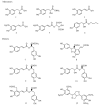Biosynthesis, Chemistry, and Pharmacology of Polyphenols from Chinese Salvia Species: A Review
- PMID: 30609767
- PMCID: PMC6337547
- DOI: 10.3390/molecules24010155
Biosynthesis, Chemistry, and Pharmacology of Polyphenols from Chinese Salvia Species: A Review
Abstract
Salvia species find widespread application in food and pharmaceutical products owing to their large polyphenol content. The main polyphenols in Chinese Salvia species are phenolic acids and flavonoids, which exhibit anti-oxygenation, anti-ischemia-reperfusion injury, anti-thrombosis, anti-tumour, and other therapeutic effects. However, there are few peer-reviewed studies on polyphenols in Chinese Salvia species, especially flavonoids. This review is a systematic, comprehensive collation of available information on the biosynthesis, chemistry, and pharmacology of Chinese Salvia species. We believe that our study makes a significant contribution to the literature because this review provides a detailed literary resource on the currently available information on various polyphenolic components of Chinese Salvia species, including their bioactivities and structures. In addition, the study provides information that would encourage further investigation of this plant material as a natural resource with potential for a broad range of applications in various industries, such as the food and pharmaceutical industries.
Keywords: Salvia; biosynthesis; chemistry; pharmacology; phenolic acids; polyphenols.
Conflict of interest statement
The authors declare no conflict of interest.
Figures




Similar articles
-
In Salvia miltiorrhiza, phenolic acids possess protective properties against amyloid β-induced cytotoxicity, and tanshinones act as acetylcholinesterase inhibitors.Environ Toxicol Pharmacol. 2011 May;31(3):443-52. doi: 10.1016/j.etap.2011.02.006. Epub 2011 Feb 26. Environ Toxicol Pharmacol. 2011. PMID: 21787715
-
Comparative Analysis of the Major Chemical Constituents in Salvia miltiorrhiza Roots, Stems, Leaves and Flowers during Different Growth Periods by UPLC-TQ-MS/MS and HPLC-ELSD Methods.Molecules. 2017 May 10;22(5):771. doi: 10.3390/molecules22050771. Molecules. 2017. PMID: 28489029 Free PMC article.
-
[Research progress on salvianolic acids of Salvia miltiorrhiza].Zhongguo Zhong Yao Za Zhi. 2016 Mar;41(5):806-812. doi: 10.4268/cjcmm20160508. Zhongguo Zhong Yao Za Zhi. 2016. PMID: 28875631 Review. Chinese.
-
Isolation and identification of antioxidant constituents from the flowers of Salvia miltiorrhiza.Nat Prod Res. 2024 Aug;38(15):2653-2657. doi: 10.1080/14786419.2023.2198710. Epub 2023 Apr 6. Nat Prod Res. 2024. PMID: 37021810
-
Bioactivities, biosynthesis and biotechnological production of phenolic acids in Salvia miltiorrhiza.Crit Rev Food Sci Nutr. 2019;59(6):953-964. doi: 10.1080/10408398.2018.1474170. Epub 2018 Jul 9. Crit Rev Food Sci Nutr. 2019. PMID: 29746788 Review.
Cited by
-
Exploring a Sustainable Process for Polyphenol Extraction from Olive Leaves.Foods. 2024 Jan 15;13(2):265. doi: 10.3390/foods13020265. Foods. 2024. PMID: 38254566 Free PMC article.
-
Integrative Omics Analyses Reveal the Effects of Copper Ions on Salvianolic Acid Biosynthesis.Front Plant Sci. 2021 Oct 21;12:746117. doi: 10.3389/fpls.2021.746117. eCollection 2021. Front Plant Sci. 2021. PMID: 34745177 Free PMC article.
-
Versatility of Caenorhabditis elegans as a Model Organism for Evaluating Foodborne Neurotoxins and Food Bioactive Compounds in Nutritional Neuroscience.Mol Neurobiol. 2025 Jun;62(6):7205-7229. doi: 10.1007/s12035-025-04705-y. Epub 2025 Jan 25. Mol Neurobiol. 2025. PMID: 39863742 Review.
-
Chemical Composition, Antioxidant Potential, and Blood Glucose Lowering Effect of Aqueous Extract and Essential Oil of Thymus Serrulatus Hochst. Ex Benth.Front Pharmacol. 2021 Apr 29;12:621536. doi: 10.3389/fphar.2021.621536. eCollection 2021. Front Pharmacol. 2021. PMID: 33995021 Free PMC article.
-
Isoprenylated Flavonoids as Cav3.1 Low Voltage-Gated Ca2+ Channel Inhibitors from Salvia digitaloides.Nat Prod Bioprospect. 2021 Dec;11(6):671-678. doi: 10.1007/s13659-021-00307-y. Epub 2021 Apr 24. Nat Prod Bioprospect. 2021. PMID: 33893991 Free PMC article.
References
-
- Zhang B.B., Nie S.Q., Liang J.Y., Wu F.W., Feng F. Advances in chemical constituents and pharmacological activities of sage. Strait Pharm. J. 2014;26:1–5.
-
- Zhang Z.F., Chen H.S., Li Z.R. Researches of constituents and bioactivity of Salvia spp. Chin. J. New Drugs. 2007;16:665–672. doi: 10.3321/j.issn:1003-3734.2007.09.003. - DOI
Publication types
MeSH terms
Substances
Grants and funding
LinkOut - more resources
Full Text Sources

